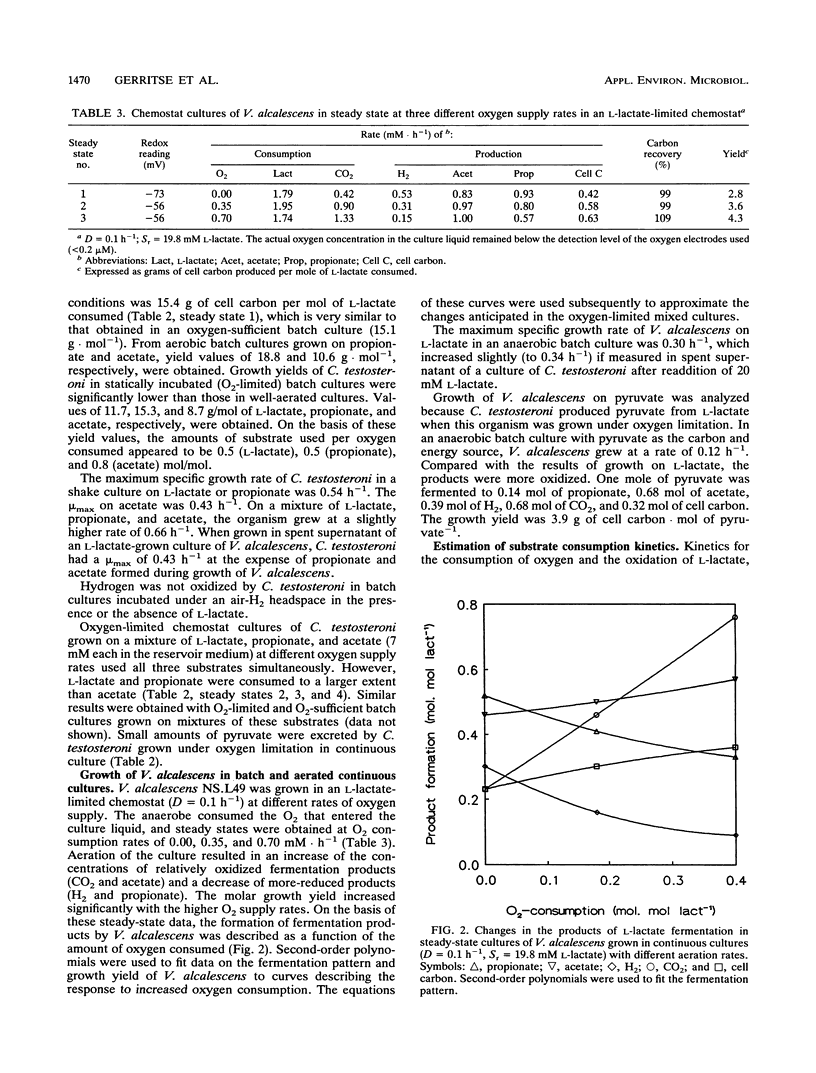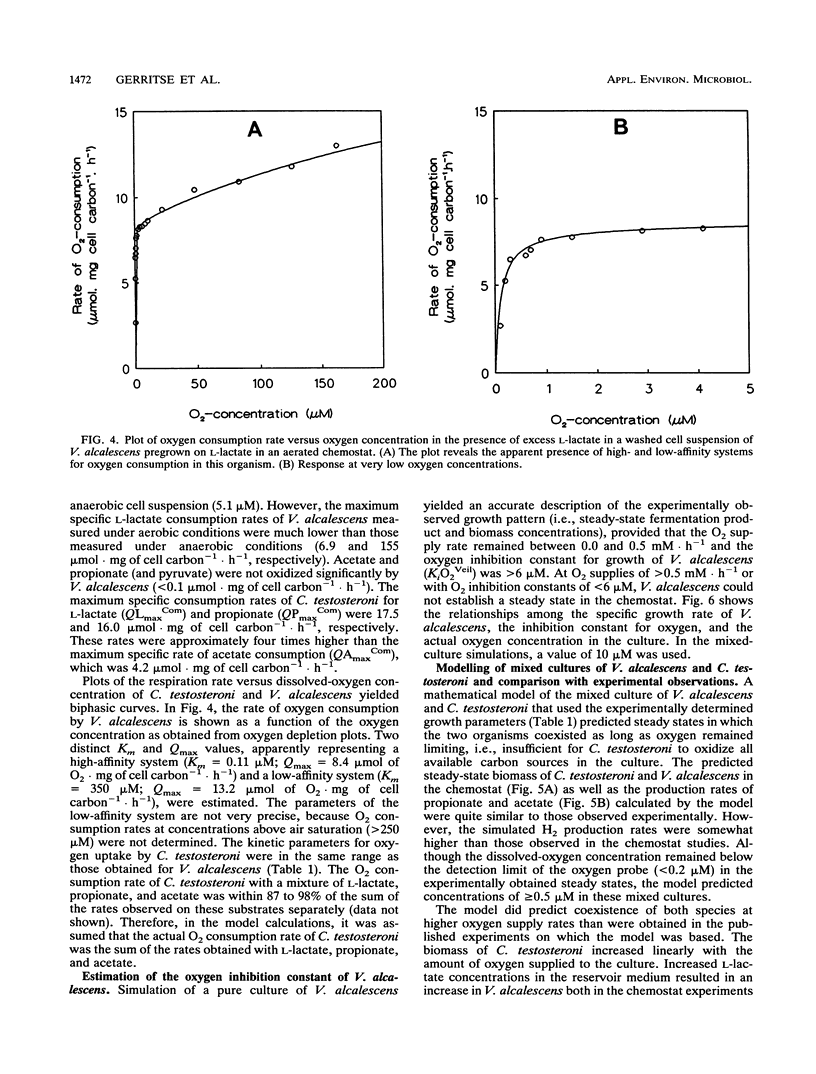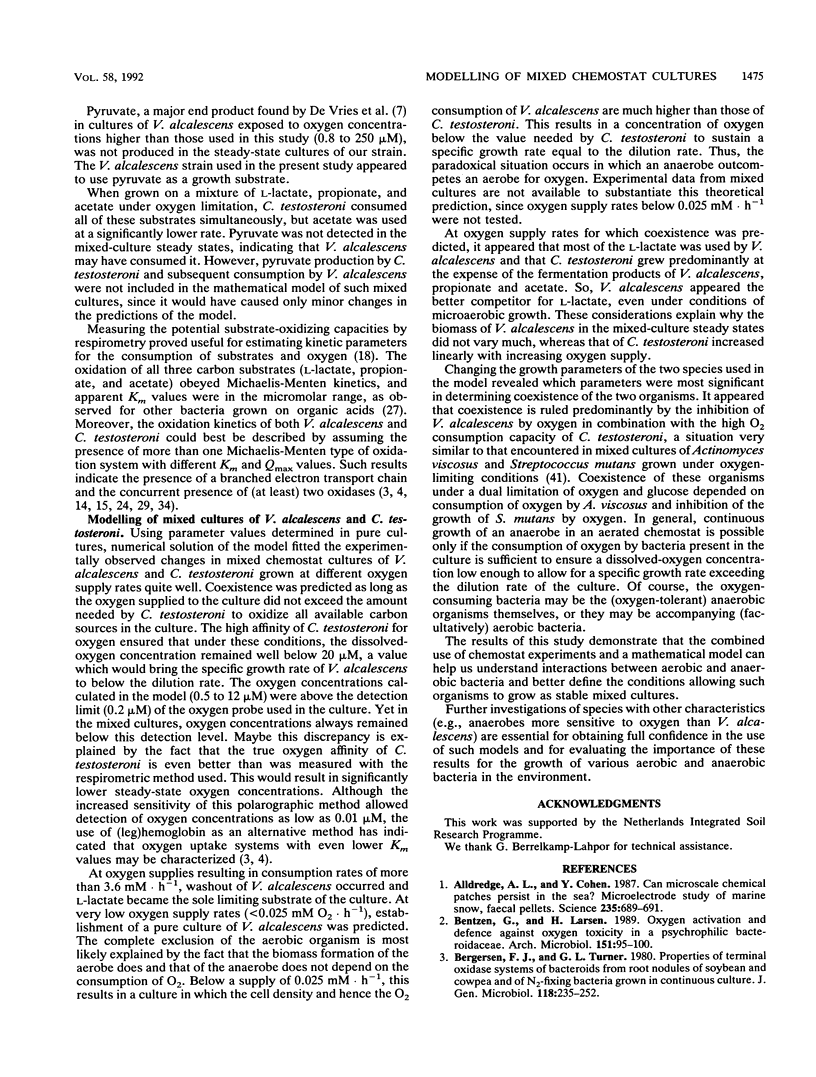Abstract
A mathematical model of mixed chemostat cultures of the obligately aerobic bacterium Comamonas testosteroni and the anaerobic bacterium Veillonella alcalescens grown under dual limitation of L-lactate and oxygen was constructed. The model was based on Michaelis-Menten-type kinetics for the consumption of substrates, with noncompetitive inhibition of V. alcalescens by O2. The growth characteristics of the aerobic and anaerobic organisms were determined experimentally with pure cultures of the individual species in (oxygen-limited) chemostats. Using these pure-culture data in the model of the mixed culture resulted in a good description of the actual mixed cultures of the two bacteria. In the actual mixed-culture experiments, coexistence of the two species occurred only when the cultures were oxygen limited. With increasing oxygen supply (the actual oxygen concentration in the culture remaining at less than 0.2 microM), the biomass of C. testosteroni increased, whereas that of V. alcalescens decreased. Apparently, C. testosteroni protected V. alcalescens from inhibition by oxygen by maintaining sufficiently low oxygen concentrations. The model calculations indicated that competition between the aerobic and the anaerobic bacterium for common substrates (L-lactate and oxygen) occurred and that the anaerobe was the better competitor. Analysis of the culture fluid indicated that C. testosteroni grew primarily at the expense of the fermentation products of V. alcalescens, i.e., propionate and acetate. The model further indicated that with different values of several growth parameters (e.g., substrate affinity and/or inhibition constants), the affinity of the aerobic organism for oxygen and the sensitivity of the anaerobic organism for oxygen were the most important properties determining the coexistence of these two physiologically different types of bacteria.
Full text
PDF










Selected References
These references are in PubMed. This may not be the complete list of references from this article.
- Alldredge A. L., Cohen Y. Can microscale chemical patches persist in the sea? Microelectrode study of marine snow, fecal pellets. Science. 1987 Feb 6;235(4789):689–691. doi: 10.1126/science.235.4789.689. [DOI] [PubMed] [Google Scholar]
- Bentzen G., Larsen H. Oxygen activation and defence against oxygen toxicity in a psychrophilic Bacteroidaceae. Arch Microbiol. 1989;151(2):95–100. doi: 10.1007/BF00414420. [DOI] [PubMed] [Google Scholar]
- Henry M. F., Vignais P. M. Induction by cyanide of cytochrome d in the plasma membrane of Paracoccus denitrificans. FEBS Lett. 1979 Apr 1;100(1):41–46. doi: 10.1016/0014-5793(79)81127-8. [DOI] [PubMed] [Google Scholar]
- LOWRY O. H., ROSEBROUGH N. J., FARR A. L., RANDALL R. J. Protein measurement with the Folin phenol reagent. J Biol Chem. 1951 Nov;193(1):265–275. [PubMed] [Google Scholar]
- Loesche W. J., Gusberti F., Mettraux G., Higgins T., Syed S. Relationship between oxygen tension and subgingival bacterial flora in untreated human periodontal pockets. Infect Immun. 1983 Nov;42(2):659–667. doi: 10.1128/iai.42.2.659-667.1983. [DOI] [PMC free article] [PubMed] [Google Scholar]
- Poole R. K. Bacterial cytochrome oxidases. A structurally and functionally diverse group of electron-transfer proteins. Biochim Biophys Acta. 1983 Sep 15;726(3):205–243. doi: 10.1016/0304-4173(83)90006-x. [DOI] [PubMed] [Google Scholar]
- Pritchard G. G., Wimpenny J. W., Morris H. A., Lewis M. W., Hughes D. E. Effects of oxygen on Propionibacterium shermanii grown in continuous culture. J Gen Microbiol. 1977 Oct;102(2):223–233. doi: 10.1099/00221287-102-2-223. [DOI] [PubMed] [Google Scholar]
- Rice C. W., Hempfling W. P. Oxygen-limited continuous culture and respiratory energy conservation in Escherichia coli. J Bacteriol. 1978 Apr;134(1):115–124. doi: 10.1128/jb.134.1.115-124.1978. [DOI] [PMC free article] [PubMed] [Google Scholar]
- de Vries W., Donkers C., Boellaard M., Stouthamer A. H. Oxygen metabolism by the anaerobic bacterium veillonella alcalescens. Arch Microbiol. 1978 Nov 13;119(2):167–174. doi: 10.1007/BF00964269. [DOI] [PubMed] [Google Scholar]


